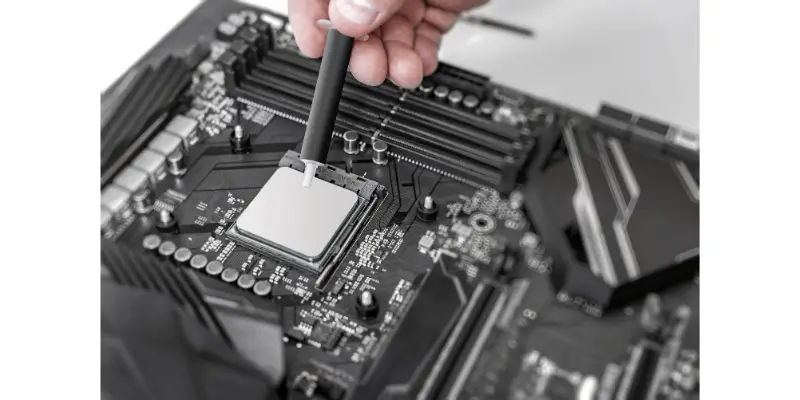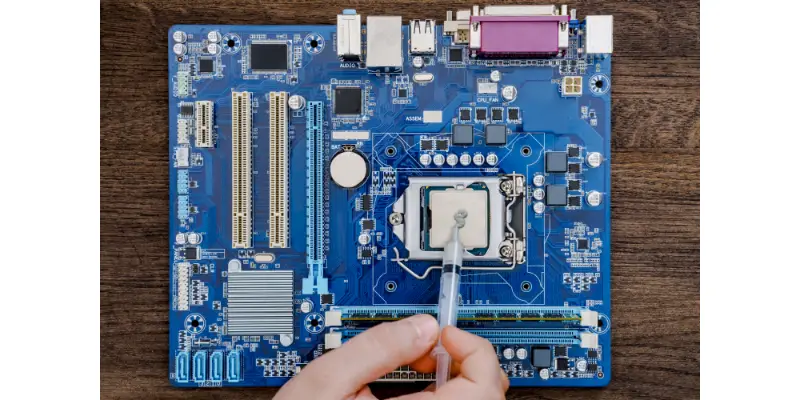Disclaimer: This post may contain affiliate links, meaning we get a small commission if you make a purchase through our links, at no cost to you. For more information, please visit our Disclaimer Page.
If you’re someone who regularly upgrades the internal hardware of your computer, you’ve probably noticed that the CPU and motherboard need thermal paste.
When it is correctly applied, it could improve the heat transfer, but if there is too much thermal paste, this can damage the motherboard or its sockets. In this case, I would say, the less the better.
Thermal paste or compound is a substance commonly made of artic silver, or silicone and zinc. This helps to improve heat transfer because of its components, but also because it fills the groove on the surface of the CPU and the cooling system base plate.
Table of Contents
Can Thermal Paste Damage the Motherboard?
Thermal paste is a high conductivity paste that helps with heat transferring. The paste is applied between an electronic component (in computers, it’s commonly the processor) and the heat sink. When this is applied correctly, the heat is successfully transferred between the CPU and the heat sink, as a result, the computer maintains a more stable and safe temperature.
But, using thermal paste excessively will shorten the life of the component where this is applied. When it is about thermal paste, the less the better.
Thermal paste can be used to help cover imperfection when the heat sink is installed in the surface of a component. However, when too much of it is put between both components, this tends to spread over the surface of the motherboard causing a lack of connectivity, and in the worst of the scenarios, a short circuit.
Thus, some CPUs come with thermal paste from the fabric, already applied by the manufacturer, so there is less of a probability that something happens to the motherboard.
In an air-cooling system, the heat sink is right over the processor, and a fan is placed just in front of these, but the surface of the microprocessors and CPUs is not perfectly flat, and they may have some mini groove –most of the times, these are imperceptible.
While people may think these grooves do not affect, this may reduce the heat dissipation, maybe not considerably, but if someone wants a fully optimized heat dissipation system, thermal paste is an option.
What Happens If Thermal Paste Gets on The Motherboard Socket?
There are two types of thermal paste: a non-conductive compound and a conductive one. Non-conductive thermal compounds are mostly made of silicon and zinc.
It is the conductive thermal paste that’s usually made of Arctic Silver that has high electrical conductivity, and consequently, a better thermal conductivity. Both types not only vary on the conductivity, but viscosity, and as a result, their composition.
Conductive thermal paste is preferred by many, but the reality is that, while it is good for heat dissipation, it has to be applied carefully because otherwise, it can cause a short circuit in the motherboard. Thus, when thermal paste gets in contact with the motherboard sockets, they may never work properly again, or just never work.
They are extremely delicate, and they can never be touched. If thermal paste gets on the motherboard sockets don’t even try to clean them, it is just worse!
The motherboard has sockets that helps attach the processor. The sockets have small short pins that line up the processor to the motherboard; the pins are stiff and this doesn’t have to be forced.
The sockets have chipsets that manage the data on the CPU and the motherboard; these are electronic components and when these are blocked by something like a thermal paste, this will never work again.
Thermal paste has to be applied carefully; conductive or non-conductive compound, can cause damage on the motherboard, so thermal paste should be applied by an expert, or be careful when this is going to be applied.
Do You Need Thermal Paste When Changing the Motherboard?
There are diverse opinions about this, though, some people would recommend applying once again. When the motherboard is changed, it is because the processor was changed, too. Subsequently, the thermal compound that was applied before is now gone, and it has to be reapplied on the new processor.
But, if the motherboard is changed for any other reason, and it is not related to the acquisition of a new processor, it is not necessary to apply the thermal paste once again.
Thus, some parties would recommend cleaning the old thermal paste with alcohol and applying it again to avoid microscopic air bubbles in the surface of the processor and heatsink when these were moved from the motherboard.
Now, if the paste has dried, it needs to be changed, cleaned up and reapplied with some new thermal compound.
The gaps between the heatsink and processor avoid optimized heat dissipation. The surfaces of both components are not perfectly flat and this obstructs the heat transferring from the CPU to the heatsink. Here is where the thermal paste is important, this fills up the grooves of the surfaces and optimizes the heat transfer.
Since there are two different types of thermal paste, people prefer the conductive compound because it is better for heat transfer; thus, its thermal conductive is as high as its electrical conductivity. So, when this is reapplied, I’m extremely careful with the amount that is applied.
If the conductive thermal compound touches the motherboard, it can cause a short circuit and severely damage the motherboard!
How to apply thermal paste to the CPU?
Thermal paste has to be carefully applied, otherwise, it can cause damage to the motherboard. But before explaining how to apply this, I recommend always using thermal paste!
There are some people over the internet that recommend toothpaste to supplant the thermal paste; this is no-sense, toothpaste will dry faster, it is not optimized for heat transfer, and it can damage another component! The thermal paste is made especially for this, don’t even try it to supplant it.
Before applying the thermal compound, clean the surface of the processor and the heatsink, any dirt interferes in the heat transfer. Also, if it is a motherboard changing, never apply the thermal paste over the old one, clean it up, and then apply it. Moreover, make sure that everything is ready for the ensemble, and this is the last step.
Now, it is simple to use a thermal compound, just be careful! Follow the next instructions to the letter:
- Put just a tiny amount of thermal paste in the center of the processor. When it is a square base plate, draw an X instead of putting it in there. Some people say to put a drop of the compound as the size of a grain pea, but that is too much, it is a little bit more than half of that!
- Now, place the base plate of the cooling system in front of the CPU, and start pressing it carefully against the processor. Don’t add too much pressure, just enough to distribute the thermal paste over both surfaces.
- Finally, attach the cooling system, and that is it! I recommend checking everything once again, and if you think that it’s necessary to start again, do it, but the thermal paste has to be cleaned, and more of this must be added.
- When the base plate is separate from the processor, the purpose of having any air interfering will be lost. When this is placed again without cleaning the compound, micro-air bubbles will be formed.
How Do You Clean Thermal Paste Off a Motherboard?
On the market, there are plenty of options, brands and products –very expensive– that are sold as thermal paste cleaners. These are good and accomplish very well their tasks, but there is also a cheaper option: isopropyl alcohol. The isopropyl alcohol is a good thermal compound thinner and doesn’t damage any of the components of the CPU.
So, to clean the thermal paste is only needed:
- A little bit of isopropyl alcohol
- 2 pieces of cloth that don’t have as few fibers on the surface as possible; I recommend using a microfiber cloth.
Now, the procedure to clean the thermal paste off the base-plate and processor is:
- Clean the thermal paste with one of the cloth pieces. Do it softly, and try to remove as much as possible.
- Dip the tip of the other cloth pieces, and press it to extract the excess. Wipe the surface of both components, and let it dry.
Conclusion
Thermal paste is useful, but a wrong application can damage the motherboard. Many consider it as a need, and others just an option; thus, an optimized cooling system will include the thermal paste.


